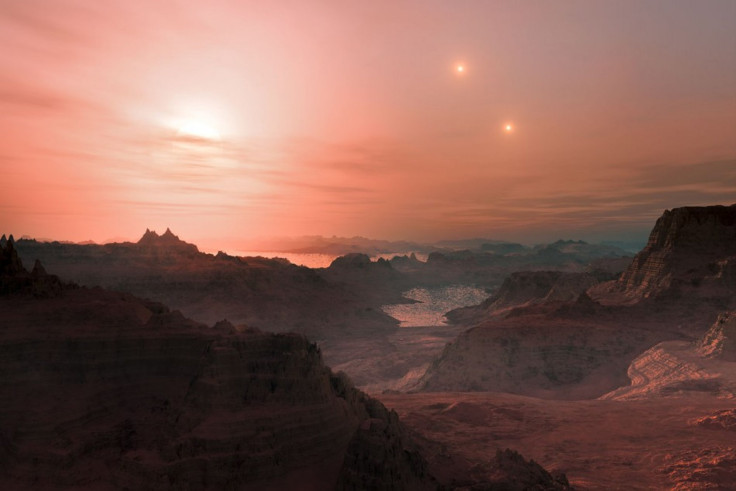Milky Way Harbors Billions of Planets Where Life Could Flourish: Study

Red dwarf stars are some of the most common and long-lived stars in the galaxy -- and many of them may harbor planets that could support life, according to new research announced Wednesday.
European researchers examined 102 red dwarf stars over six years and found a total of nine super-Earths -- planets with a mass between one and 10 times that of our planet. Two of the exoplanets orbit at just the right distance from their suns to place them in the habitable zone where liquid water can exist, according to a paper that will appear in the journal Astronomy & Astrophysics.
One of the super-Earths, Gliese 667Cc, orbits in the habitable zone around one of the stars in a triple-star system about 22 light years from Earth.
Extrapolating from their observations, the team estimates that about 41 percent of red dwarfs contain at least one super-Earth at the sweet spot for life. With an estimated 160 billion red dwarfs in the Milky Way, tens of billions of such planets potentially exist.
Experts say the latest findings are hardly a surprise.
The galaxy is positively lousy with habitable planets, says Geoffrey W. Marcy, an astronomer at the University of California, Berkeley, which wasn''t affiliated with the study.
For planets, occupying a habitable zone around a star is a delicate balance. Too far away and the planet freezes; too close and any water will boil off into space. The mass of the planet also factors in as to whether or not it might support life. Too small and it can't hold onto any atmosphere; too large and it attracts a lot of hydrogen and helium, which makes for an inhospitable climate.
Searching for exoplanets is a lot harder than just pointing the telescope in the right direction, as it turns out.
When we try to detect planets, visually we cannot take a picture, says Xavier Bonfils of Grenoble University in France, one of the lead authors of the study.
Because red dwarf stars are smaller and colder, the habitable zone around them is much closer than the one around our sun. Super-Earths in close orbit around red dwarfs would be obscured by the star's light.
So, scientists use a technique called radial velocity, which measures the slight gravitational pull of the planet on the star as both orbit a common center of mass.
To visualize this technique, imagine two people on a seesaw, one very tiny and one very large. You can infer something about the movement of the tiny person by looking at how the large person moves, says Steven Vogt, an astronomer at the University of California Santa Cruz, which wasn't affiliated with the study.
The European researchers used the HARPS spectrograph on the European Southern Observatory's telescope in Chile to detect if a planet is perturbing the motion of a star. They can also estimate a lower bound on the planet's mass -- not quite an exact figure, but enough for a rough estimate.
What the radial velocity method can't determine, though, is the actual size of the planet. That's a key piece of the puzzle, says William Borucki, a scientist at NASA's Ames Research Center who works on the agency's Kepler mission, which is also searching for habitable planets.
Without knowing an exoplanet's size, scientists can't calculate its density. So there's no way to tell if the super-Earths found by the HARPS team are large gas giants like Neptune or Jupiter, or rocky planets like Earth, Borucki says.
The Kepler mission uses a method called transit photometry to figure out the sizes of planets by looking at how the light of a star changes when a planet passes in front of it. Measuring the dimming of the star's light allows scientists to determine the ratio between the size of the planet and the size of the star. Then, taking the known size of the star, one can work backwards to determine the size of the planet.
Borucki cautions that a lot of assertions about exoplanets are interpretations, since scientists still don't have instruments that can directly observe these objects.
Our technology is allowing us to get these clues, these hints. The numbers are reasonable, but there's lots of uncertainties, he says.
Even given a planet of the right mass, right size, and at the right distance from a red dwarf, there may still be barriers to the formation of life.
Many red dwarfs throw off lots of solar flares that would bathe exoplanets in UV radiation and X-rays. It's also likely that many of the exoplanets in the habitable zone would be tidally synchronized so one face of the planet would constantly face the sun, according to Vogt.
Still, Vogt says life might find a way. Winds on the planet could recirculate the temperature and atmosphere to make it a bit more habitable. Perhaps the border zone between constant day and constant night might provide a more temperate climate, resulting in a ribbon of life between scorching desert and frozen wasteland.
And who knows? Life on other planets might enjoy swimming in X-rays.
What Vogt finds really exciting about the possibility of lots of likely habitable planets around red dwarf stars is how close by they are. The HARPS team estimates that there are probably about 100 super-Earths in habitable zones less than 30 light years away.
You could imagine having a conversation with them in a human lifetime, Vogt says.
© Copyright IBTimes 2024. All rights reserved.





















